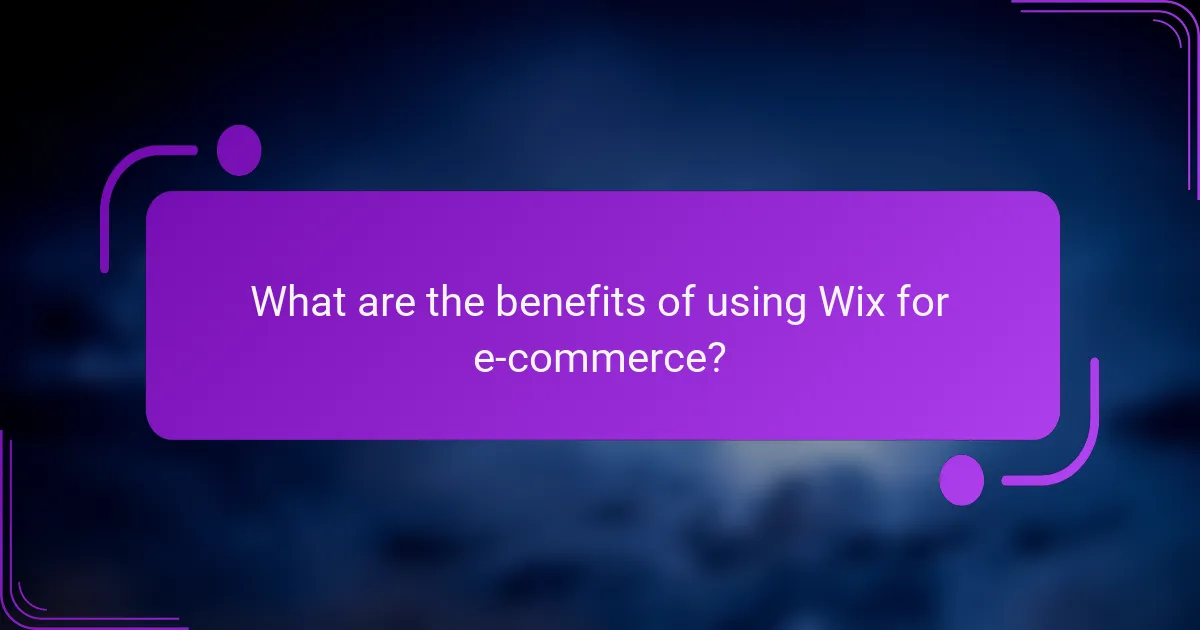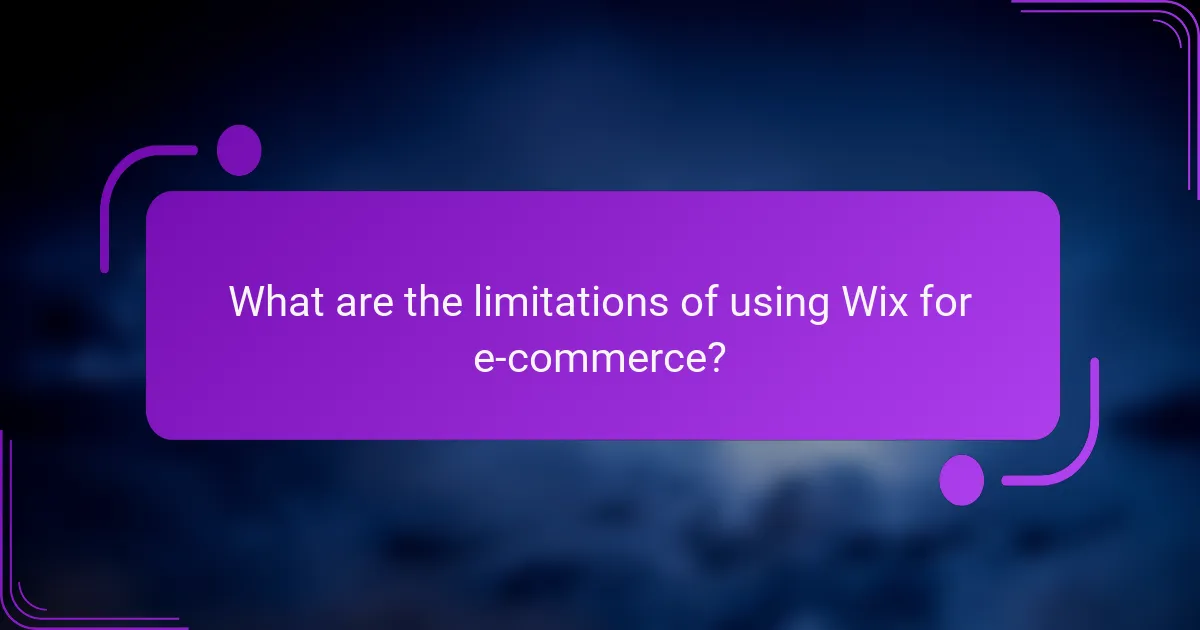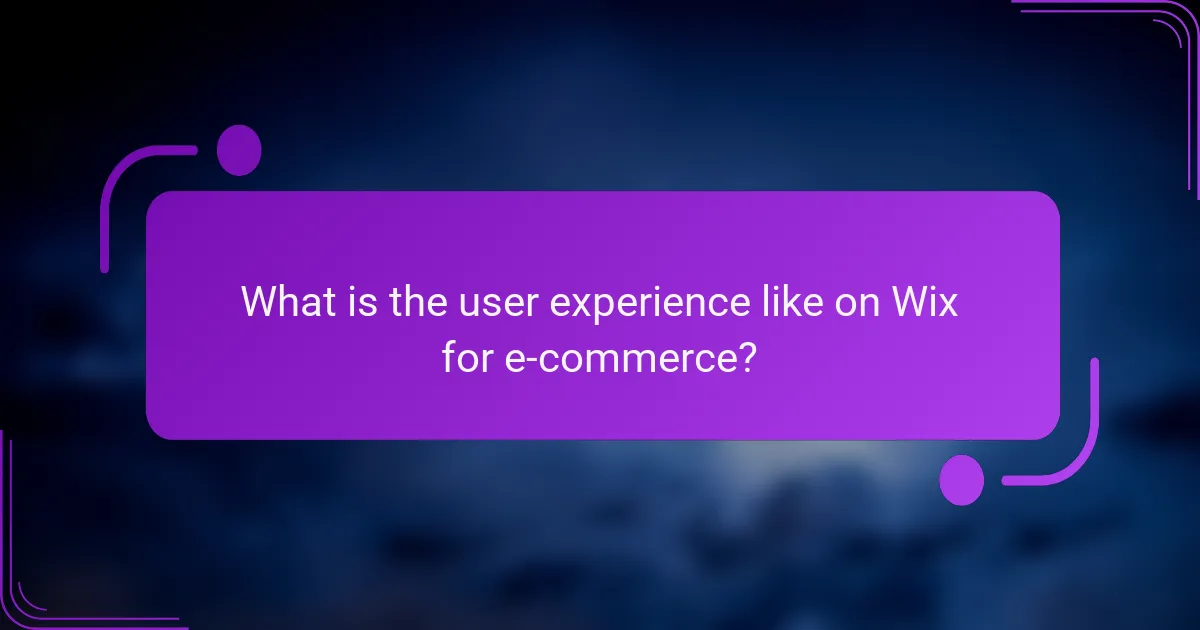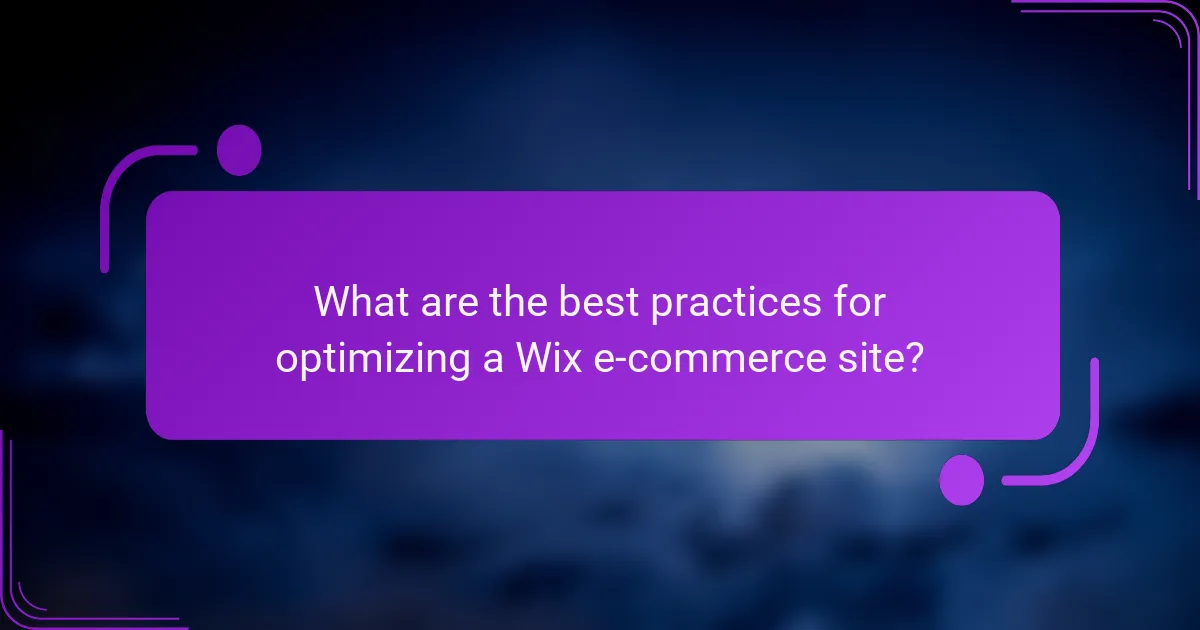Wix provides an accessible platform for e-commerce, featuring a user-friendly interface and a variety of customizable templates that cater to small and medium-sized businesses. While it offers integrated tools to facilitate online selling, potential users should be aware of its limitations, such as transaction fees and restricted payment gateways, which may affect performance and scalability.

What are the benefits of using Wix for e-commerce?
Wix offers several advantages for e-commerce, including ease of use, a variety of design options, and integrated tools that streamline online selling. These features make it an attractive choice for small to medium-sized businesses looking to establish an online presence quickly.
User-friendly interface
The user-friendly interface of Wix allows even those with minimal technical skills to create and manage an online store. The drag-and-drop functionality simplifies the website-building process, enabling users to customize their site without needing coding knowledge.
This intuitive design helps users focus on their products and marketing rather than getting bogged down in technical details. As a result, businesses can launch their e-commerce sites faster and with less frustration.
Customizable templates
Wix provides a wide range of customizable templates specifically designed for e-commerce. Users can choose from various styles and layouts that suit their brand, making it easy to create a professional-looking website.
These templates are responsive, ensuring that the site looks good on both desktop and mobile devices. Customization options allow users to adjust colors, fonts, and images to align with their brand identity.
Integrated payment options
Wix supports multiple integrated payment options, making it convenient for customers to complete their purchases. Users can accept major credit cards, PayPal, and other payment methods, which can enhance the shopping experience.
Additionally, Wix provides tools to manage transactions securely, ensuring compliance with industry standards. This integration helps businesses streamline their payment processes and reduce cart abandonment rates.
SEO tools
Wix includes built-in SEO tools that help optimize e-commerce sites for search engines. Users can easily edit meta tags, alt text, and URLs to improve their site’s visibility online.
These features are crucial for driving organic traffic to the store. By utilizing Wix’s SEO capabilities, businesses can enhance their chances of ranking higher in search results, attracting more potential customers.
Scalability
Wix is designed to grow with your business, offering scalability that accommodates increasing inventory and traffic. As a business expands, users can upgrade their plans to access more advanced features and storage options.
This flexibility allows businesses to start small and gradually enhance their online presence without needing to switch platforms. It ensures that as sales increase, the website can handle the growth efficiently.

What are the limitations of using Wix for e-commerce?
Wix offers a user-friendly platform for e-commerce, but it has several limitations that can impact your online store’s performance and scalability. Key concerns include transaction fees, limited payment gateways, and challenges with advanced features.
Transaction fees
Wix charges transaction fees on sales made through its platform, which can reduce your overall profit margins. These fees typically range from around 2.9% plus a fixed amount per transaction, depending on your plan. If you’re operating a high-volume store, these costs can add up quickly.
Limited payment gateways
Wix supports a limited number of payment gateways compared to other e-commerce platforms. While it includes popular options like PayPal and Stripe, it may not support specific regional payment methods that your customers prefer. This limitation can hinder your ability to cater to a diverse customer base.
Less flexibility for advanced features
Wix is designed for ease of use, which means it lacks the flexibility needed for advanced e-commerce features. Customizations, such as complex inventory management or unique checkout processes, may not be possible. Businesses looking for tailored solutions may find Wix restrictive.
Performance issues with large inventories
As your inventory grows, Wix may struggle to maintain optimal performance. Users with large product catalogs have reported slower load times and difficulties in managing their stores efficiently. This can lead to a poor user experience for customers, potentially affecting sales and retention.

How does Wix compare to other e-commerce platforms?
Wix offers a user-friendly interface and a range of customizable templates, making it a solid choice for small to medium-sized online stores. However, it may lack some advanced features found in dedicated e-commerce platforms like Shopify or BigCommerce.
Wix vs Shopify
Wix and Shopify cater to different types of users. Shopify is specifically designed for e-commerce, providing extensive features like advanced inventory management and multi-channel selling. In contrast, Wix is more versatile, allowing users to create various types of websites, but it may not support complex e-commerce needs as effectively as Shopify.
For example, Shopify offers built-in tools for shipping, payment processing, and customer management, which can be crucial for larger businesses. Wix, while offering basic e-commerce functionalities, may require third-party integrations for more advanced features.
Wix vs BigCommerce
BigCommerce is another platform that focuses heavily on e-commerce, providing robust tools for scaling online businesses. It excels in features like SEO optimization and multi-currency support, which can be beneficial for businesses targeting international markets. Wix, while user-friendly, may not offer the same level of scalability or advanced features as BigCommerce.
For instance, BigCommerce allows for unlimited product listings and has built-in analytics tools, making it suitable for larger operations. Wix is ideal for smaller shops or those just starting, but may require upgrades as a business grows.
Wix vs Squarespace
Wix and Squarespace both offer visually appealing templates and user-friendly interfaces, but they serve slightly different purposes. Squarespace is known for its design-centric approach, making it a favorite among creatives, while Wix provides more flexibility in terms of customization and functionality for e-commerce.
For e-commerce, Wix offers a wider range of apps and integrations, which can enhance a store’s capabilities. Squarespace, on the other hand, has a more streamlined approach but may lack some e-commerce-specific features that Wix provides, such as extensive payment options and shipping integrations.

What is the user experience like on Wix for e-commerce?
The user experience on Wix for e-commerce is generally intuitive and user-friendly, making it accessible for individuals without extensive technical skills. The platform provides a range of features tailored for online stores, allowing users to set up and manage their e-commerce sites efficiently.
Ease of setup
Wix offers a straightforward setup process for e-commerce sites, often taking just a few hours to complete. Users can choose from various templates specifically designed for online stores, which simplifies the design phase. The drag-and-drop interface allows for easy customization without needing coding knowledge.
However, users should be aware that while the initial setup is simple, integrating advanced features or custom functionalities may require additional effort or third-party apps. It’s advisable to plan ahead and consider future needs when selecting a template.
Customer support options
Wix provides multiple customer support options, including a comprehensive help center, email support, and a community forum. Users can access tutorials and guides that cover various aspects of e-commerce management, from product listings to payment processing.
For more immediate assistance, Wix also offers a premium support option, which includes priority response times. However, some users have reported that response times can vary, so it’s beneficial to utilize the help center for common issues before reaching out directly.
Mobile responsiveness
Wix ensures that e-commerce sites are mobile responsive, automatically adjusting layouts for optimal viewing on smartphones and tablets. This is crucial as a significant portion of online shopping occurs on mobile devices, and a seamless experience can enhance customer satisfaction and conversion rates.
Users can preview and edit their mobile site separately from the desktop version, allowing for tailored adjustments. However, it’s important to regularly test the mobile experience to ensure that all features function correctly and that the site remains user-friendly across different devices.

What are the best practices for optimizing a Wix e-commerce site?
To optimize a Wix e-commerce site effectively, focus on enhancing user experience, improving search engine visibility, and showcasing products attractively. Implementing best practices in SEO, product descriptions, and image quality can significantly boost engagement and sales.
SEO optimization techniques
SEO optimization is crucial for increasing visibility in search engines. Start by conducting keyword research to identify terms your target audience is searching for, then incorporate these keywords naturally into your site’s content, including product titles, descriptions, and meta tags.
Utilize Wix’s built-in SEO tools to manage your site’s settings. Ensure that your URLs are clean and descriptive, and consider creating a blog to provide valuable content that can drive traffic. Regularly updating your site with fresh content can also improve your search rankings.
Effective product descriptions
Product descriptions should be clear, concise, and persuasive. Highlight key features, benefits, and specifications to help customers make informed decisions. Use bullet points for easy readability and include relevant keywords to enhance SEO.
Avoid generic phrases; instead, personalize descriptions to reflect your brand’s voice. Consider including customer reviews or testimonials to build trust and provide social proof, which can encourage potential buyers to make a purchase.
High-quality images
High-quality images are essential for showcasing products effectively. Use clear, well-lit photos that accurately represent your items from multiple angles. Consider including zoom features or 360-degree views to enhance the shopping experience.
Optimize image sizes to ensure fast loading times without sacrificing quality. Aim for images that are under 100 KB for quick loading while maintaining clarity. This balance is vital, as slow-loading images can lead to higher bounce rates and lost sales.
